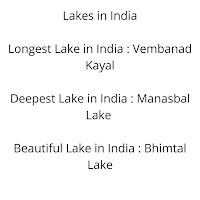Table of Contents
Lakes in India
A Lake derived from the Latin word ‘lacus‘ means, a large body of water within a body of land. Lakes are different from both Rivers and seas.
Lakes do not flow like rivers, although many rivers flowing into or out of lakes. India is considered a diverse culture in terms of topographical features.
Lakes in India cover an important part of India’s varied topographical features. Lakes are generally static, unlike rivers.
Temperature, light, and wind are those factors that affect the physical characteristics of Lakes in India.
Different Types of Lakes in India: ??
Formation of Lakes in India can be mainly described under three types which we will be discussing below :
1. Saltwater lakes – Formation of lakes mostly in coastal areas with island drainage or in the shape of Spit and bars lagoons are termed as Saltwater lakes.
Chilika and Kolleru lake are in form of lagoons whereas Sambhar lake in Rajasthan is formed due to island drainage and its water is used for salt production.
2. Freshwater lakes – These lakes are mostly glacier origins found in the Himalayan region. When glaciers dug out a basin and basin filled with melt snow, it results in freshwater lakes.
The most important freshwater lakes in India are Wulur lake, Dal Lake, and Nainital lakes.
3. Man–made lakes – Rivers are dammed in order to generate power and it results in the formation of man-made lakes.
These man-made lakes are also constructed as the drain of excessive water of the river during floods.
Guru gobind Sagar, Nizam sagar, and Rana pratap sagar are some important examples of Man made lakes .
How many lakes are in India?
It is known to be around 250 total lakes in India. Out of which we consider about 70 lakes as the most important lakes in India.
These lakes are either natural lakes (Saltwater or Freshwater lakes) or Man-made lakes.
These lakes serve various useful purposes to their locality and are often considered as the most important part of topographical creation.
 |
| Longest-Deepest-Beautiful Lake |
Which are the main lakes in India?
As discussed above there are around 70 lakes in India that are considered important lakes. Let us know few important facts about lakes in India.
Wulur lake in Jammu and Kashmir is the largest freshwater lake in India, whereas Chilka lake in Orisa is considered as largest saltwater lake. It is a famous lake in India.
Vembanad lake in Kerla is the longest lake in the country.
Kolleru lake in Andhra Pradesh is the largest lake in India.
Cholamu lake in Sikkim is at the highest altitude.
Dal Lake in Srinagar is considered an integral part of tourism in India and often known as “Jewel in the crown of Kashmir”famous Mughal garden, Asia’s largest tulip garden all these are situated on the bank of Dal Lake.
Nalsarovar lake in Gujarat and the wetlands around it are declared as Bird Sanctuary in the year 1969.
Hussain Sagar lake in Telangana connects two major cities in the state, Hyderabad, and Secunderabad.
Also, visit site related to digital Ideas.
Lonar Lake in Maharastra has formed 50000 years ago when a meteorite hit the Earth.
Pulicat lake in Andhra Pradesh is one of the largest lagoons in India and is home to the Satish Dhawan Space Centre for its various launches including the successful Chandrayaan mission.
Along with the three important types of lakes discussed above, Crater lake and Oxbow lake are also formed in general.
Crater lakes are generally created due to volcanic activity whereas Oxbow lakes are formed by river deposits.
Kanwar Lake in Bihar is Asia’s largest Oxbow lake, whereas Nakki lake in Rajasthan is situated in the Indian hill station of Mount Abu.
Man-made lakes in India :
In addition to natural lakes, some of the important men made lakes are also Created in India.
These lakes are useful for storing excess water from the river during flood situations or as a store to river water during power generation.
Bhojtar Lake is the largest man-made lake in Asia.
Barapani lake was originated in the year 1965 due to the Hydroelectric power project, which was the first hydel power project in Northeastern India.
Govind Sagar lake in Bilaspur Himachal is a part of Bhakhra Dam and it is enormous in size.
Jaisamand Lake in Udaipur is the second-largest man-made lake in Asia. It is most famous for offering peace and a soothing environment to the visiting tourists.?
Bhimtaal lake in Uttarakhand is an incredible site to visit after a tiring day because of its serenity it offers Bhimtal lake in Uttarakhand is the largest lake in the Kumaon region and is a C shaped lake. ?
Hirakund lake in Sambalpur orisa and Nagarjuna Sagar in Nalkonda Telangana is an ideal destination for a weekend plan and often famous for its delicious cuisine. ?
To Wrap Up – Lakes in India serve an important part. Lakes add to the major tourist attractions. Lakes in India are also used as a reservoir for fresh water and can be used for domestic purposes.
Lakes are an important source of water supply for industry and irrigation purposes. For developing hydel power generation, Lakes play an important part.
Lakes in India helps to maintain the ecosystem balance and climate of the region. It provides a habitat for aquatic species. Overall Lakes are pivotal to increase the economy of our country.
Thane is also known as the city of lakes in India.
Lake Kariba is India’s largest artificial lake.
Read the PDF about Lakes in India:-
Source: cracku.in
Conclusion:-
Also visit Mera Fasal Mera boyra

Nice article